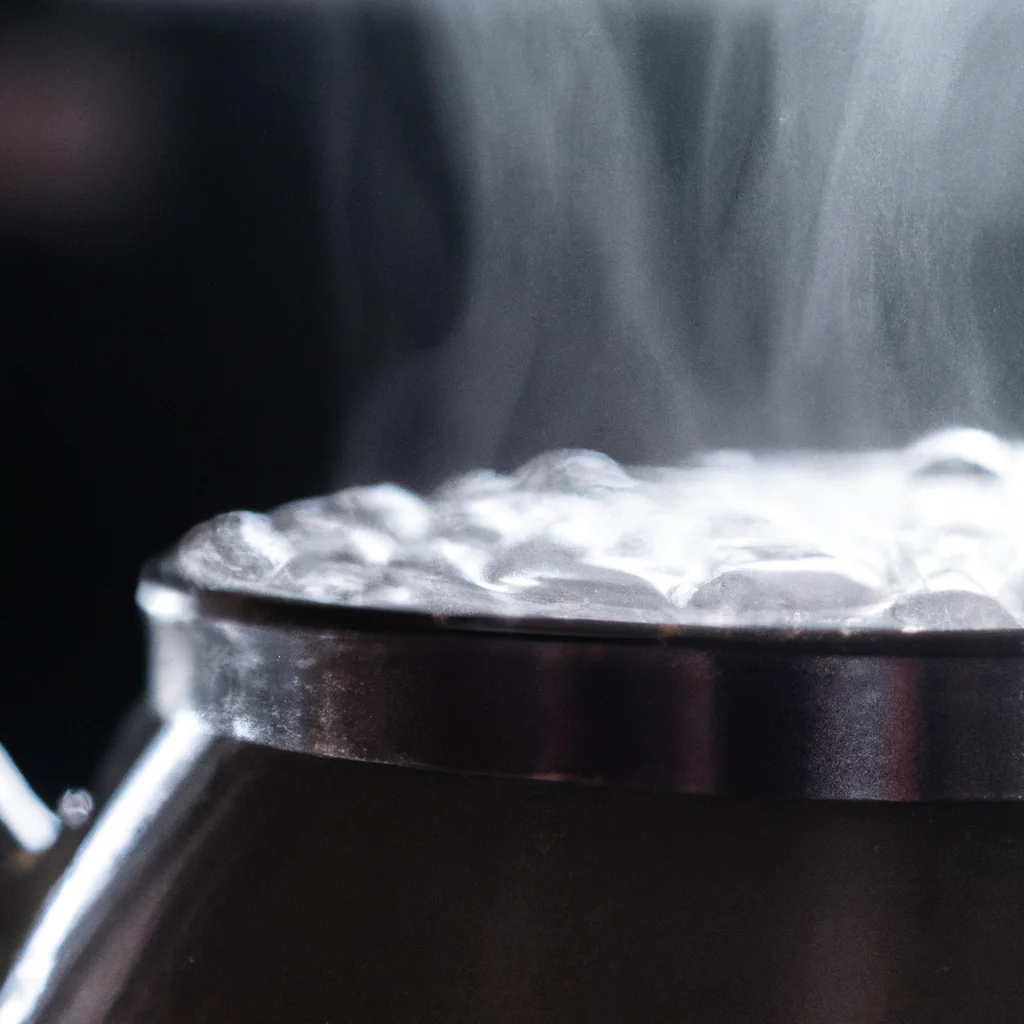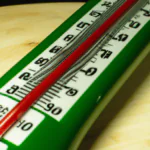Steam is one of the most potent forces in nature, and it can be used to power everything from locomotives to electricity-generating turbines. But what is the temperature of steam and how hot can it get?
In this article, we will look at steam, its temperature, and everything else you need to know about steam and its temperature. Read on to learn all about this incredible force of nature.
Table of Contents
Can steam be hotter than 100 degrees?
Steam can indeed be hotter than 100 degrees Celsius. For example, a pressure cooker operates at a cooking pressure setting of 1.8 to 2.0 bar (absolute) – much higher than water’s boiling point.
Thus, steam generated under pressure can reach temperatures well above 100 degrees Celsius.</strong
Pressure cookers are great kitchen tools that help prepare food quickly and efficiently. By increasing the pressure in the pot, it essentially raises the temperature inside and cooks food faster. You can cook various foods such as rice, stews, and even cakes in a pressure cooker.
Here are some benefits of using a pressure cooker:
- It’s fast. Cooking time can be reduced by up to 70%.
- It’s energy efficient. Pressure cookers use less energy than traditional cooking methods.
- It preserves nutrients and flavor. Pressure cooking seals in all the juices and flavor for healthier and tastier results.
- It is safe to use as long as instructions are followed.
So if you’re looking for an appliance that provides delicious, fast and healthy meals, then a pressure cooker is worth considering!
Steam temperature: What is it in Celsius?
Atmospheric pressure influences the boiling point of water. When the atmospheric pressure at sea level is about 1013 mbar, the boiling point of water is 100 degrees Celsius.
Steam is the gaseous form of water and it only exists when water has been heated to it’s boiling point and then evaporated. This is why steam is often thought of as a hot gas and is often referred to as “hot steam”. Since the boiling point of water at normal atmospheric pressure is 100 degrees Celsius, it follows that steam has the same temperature.
In addition, the temperature of steam can vary with atmospheric pressure. As the pressure increases, the boiling temperature of water increases. On the other hand, as the pressure decreases, so does the boiling temperature.
Therefore, if the atmospheric pressure is 1013 mbar (at sea level), the temperature of steam will be 100 degrees Celsius. Since this temperature is also the boiling point of water at that specific atmospheric pressure, this means that steam has reached a saturated vapor state and will exist until it’s cooled back down to its boiling point or until the atmosphere changes pressure.
- At sea level (1013 mbar), water boils at 100 degrees Celsius and the temperature of steam is also 100 degrees Celsius
- The boiling temperature of water changes with different pressures.
- Steam exists as long as it’s temperature remains above its boiling point.
- Steam can become cooler than its boiling point as the atmospheric pressure decreases
The starting temperature: What’s the Minimum for Steam?
Steam is an integral part of many life processes. Its use in industrial and commercial applications is vast, and it also plays a vital role in many medical procedures. Understanding its temperature range is therefore an important task.
The minimum temperature for steam is 100°C (212°F) . This temperature is essential for performing operations such as cooking, cleaning, sterilizing, and even powering machinery. But what about the upper limit? Is there a maximum temperature for steam?
This question was posted to r/askscience, and as expected, users had various answers. Some pointed out that the maximum temperature depends heavily on the pressure at which the steam is held. Others pointed out that the boiling point of water is an indicator of maximum temperature.
So how can we definitively answer this question? Well, one user suggested looking at superheated steam. This type of steam has been heated to over 100°C and its extra energy makes it ready to do more work.
At atmospheric pressure, superheated steam can reach up to 600°C!
How is this possible? Steam’s ability to hold heat is enhanced by pressure. As the pressure increases, so does its ability to hold energy. By maintaining a high enough pressure, we can achieve temperatures much higher than those found in other types of gases or liquids at similar temperatures.
The boiling point of water is a good reference point for determining the maximum temperature of steam. Since water boils at 100°C, any pressure increase will result in higher temperatures and lower boiling points until eventually, instead of boiling off, it will simply evaporate.

.
Feel the heat: What’s the hottest steam can get?
When heated at normal atmospheric pressure, water will continue to rise to a temperature of 212°F (100°C), the highest boiling point possible at that pressure. This is extremely hot, and any further increase in temperature would cause the water to evaporate into steam.
This evaporation process is called boiling, which occurs when a liquid’s temperature rises beyond a certain point. All liquids have their own boiling point – temperatures at which they will evaporate – but the maximum is 212°F (100°C) for water.
Once vaporized, vapor can reach incredibly high temperatures and has several practical uses. It can disinfect food, sterilize laboratory equipment, and create high pressure for industrial processes.
Hotter steam can be produced by increasing the atmospheric pressure around the water. When this happens, more energy is required to evaporate it, increasing its temperature.
For example, when pressure-cooking with steam, the water boils much higher than usual. This is because the surrounding pressure of the sealed pot forces more energy into the liquid, so more heat is needed to evaporate it.
The highest steam temperatures are found in boilers and other industrial machinery, where intense energy produces scalding steam. These temperatures range from 400ºF (204ºC) to 1000ºF (538ºC).
100°C: Is steam always this hot?
The answer is definitely no. Steam is the gaseous form of water, and its behavior follows the same rules as anything else that undergoes gasification. At atmospheric pressure, liquid water cannot exceed a temperature of 100C/212F without turning into steam.
What happens if liquid water reaches 100C/212F? Instead of continuing to heat up, it steals energy from its surroundings and transforms from the liquid state to the gas phase. This transition requires a tremendous amount of energy and can be quite disorienting to any unsuspecting bystander!
Currently, water vapor tends to stay just below its boiling point, sometimes as high as 99C/210F depending on atmospheric conditions. Due to evaporative cooling, it never gets too close to its target temperature of 100C/212F.
Phase changes are not to be taken lightly, as they combine potent effects with an often unexpected transformation. The combination of large power absorption and rapid shape change makes them difficult to confront or control. Fortunately, however, there are ways to mitigate their dizzying effects.
One such way is to use a pressure cooker in your kitchen! By heating water in an airtight chamber, it can reach temperatures above the boiling point without turning into a gas. Using this technique, we can enjoy flavorful stews and boiled eggs when regular boiling would produce nothing but steamy disappointment.
Steamy stuff: How hot is boiled water steam?
If you want hot tea or coffee, boiling water from a liquid to a vapor is the most common way to turn it into a drink! For pure water, the temperature at which this occurs is an impressive 212°F (100°C). But let’s explore what happens to create the steam.
The boiling process involves the water molecules moving faster and faster as they’re heated, until they move so fast that they break away from the liquid. This conversion of liquid water to vapor – or steam – is what you see boiling in a pot on the stove.
Vapor at different pressures affects the boiling point’s temperature. When water is heated under high pressure, its boiling point increases; conversely, when it is heated under low pressure, its boiling point decreases. For example, if you depressurize a container of water that is near its boiling point of 212°F/100°C, it will begin to boil even though it’s much cooler than 212°F/100°C.
Advantages of steam heating over other types of heating processes include:.
- It helps to soften and revitalize fabrics during wash cycles.
- It can be used to sterilize food by raising temperatures quickly and evenly.
- It can be used for sanitizing processes in healthcare facilities.
Disadvantages of steam heating compared to other types of heating processes include:
- The cost of producing steam can be significantly higher than other options.
- If not handled properly, there is a risk of corrosion.




